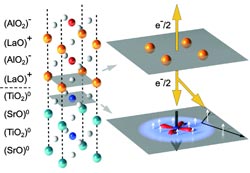Two non-magnetic materials suddenly show magnetism at their interface

Atomic layering of the materials SrTiO3 and LaAlO3 results in a charge transfer to the interface. The electrons form localised magnetic momenta in materials that aren’t magnetic by themselves.
Publication of this remarkable effect shortly follows previous results, presented in Physical Review Letters, in which scientist of Twente and Stanford explain why the same materials, being insulators as well, show current conductivity at their interface. Magnetism in nanoscale materials is a hot topic, as is also shown in the June issue of Physics Today. Magnetic layers in semiconductor structures are particularly interesting for new information carriers.
The materials showing these unexpected properties are so-called perovskites. The Inorganic Materials and Low Temperatures sections of the MESA+ Institute for Nanotechnology have examined the properties of these materials for some time now. They are oxidic materials showing other surprising features like high-temperature superconductivity and ferroelectricity. Combinations of materials, made by layering them on top of each other, yield interface properties totally differing from those of the bulk material. The interface between strontium-titanate (SrTiO3) and lanthane-aluminate (LaAlO3), both insulators, shows high current conductivity. Joint research at Twente and Stanford University show that, apart from charge that is intrinsically built up, oxygen vacancies play a major role. The research now presented in Nature Materials shows that the layers aren’t just highly conductive: the interface is magnetic as well.
Layer for layer
For studying the interface, precise control of the growth of materials on the atomic scale is vital. Using laser pulses, the scientists can ‘build’ a material unit cell for unit cell, on a carrying crystal. The unit cell is the smallest basic structure of a crystal. Growth can be monitored to the extreme detail. Looking at separate atoms within a unit cell, layers with different charges can occur. Whenever a layer with a net positive charge is placed above a layer with a negative charge, and so on, configurations are possible with an extra positive layer. These layers provide electrons, and take care for conductivity and magnetism.
Inzicht in grensvlakmagnetisme
Through tests in the High Field Magnet Laboratory of the Radboud University of Nijmegen, The Netherlands, holding one of the largest magnets in the world, the researchers gained more insight into the magnetism at the interface between strontium-titanate and lanthane-aluminate. They found out that the electrical resistance is a function of the external magnetic field. In a strong field of 30 Tesla, the resistance is 30% lower than without a magnetic field. This implies that at the intergace local magnetic momenta are present, of which the alignment has an effect upon the resistance. Apart from that, resistance and temperature are logarithmically related, which points in the direction of the so-called Kondo effect. This quantummechanical effect describes localized magnetic momenta shielded by free electrons. At extremely low temperatures (300 millikelvin) hysteresis appears in the resistance: this is a strong indication for magnetic ordening at larger distances.
Hot topic
Magnetism within thin layers, especially in semiconductor structures, forms a hot topic within physics. The new results open the way to a fully new model system for fundamental research on magnetic interaction in materials. Broadening the scope, other phenomena not appearing within the bulk, but present at the interface can be investigated.
The research has been made possible by the Dutch Foundation for Fundamental Research on Matter (FOM) and the Dutch Organisation for Scientific Research NWO.
Media Contact
More Information:
http://www.utwente.nlAll latest news from the category: Physics and Astronomy
This area deals with the fundamental laws and building blocks of nature and how they interact, the properties and the behavior of matter, and research into space and time and their structures.
innovations-report provides in-depth reports and articles on subjects such as astrophysics, laser technologies, nuclear, quantum, particle and solid-state physics, nanotechnologies, planetary research and findings (Mars, Venus) and developments related to the Hubble Telescope.
Newest articles

Combatting disruptive ‘noise’ in quantum communication
In a significant milestone for quantum communication technology, an experiment has demonstrated how networks can be leveraged to combat disruptive ‘noise’ in quantum communications. The international effort led by researchers…

Stretchable quantum dot display
Intrinsically stretchable quantum dot-based light-emitting diodes achieved record-breaking performance. A team of South Korean scientists led by Professor KIM Dae-Hyeong of the Center for Nanoparticle Research within the Institute for…

Internet can achieve quantum speed with light saved as sound
Researchers at the University of Copenhagen’s Niels Bohr Institute have developed a new way to create quantum memory: A small drum can store data sent with light in its sonic…





















